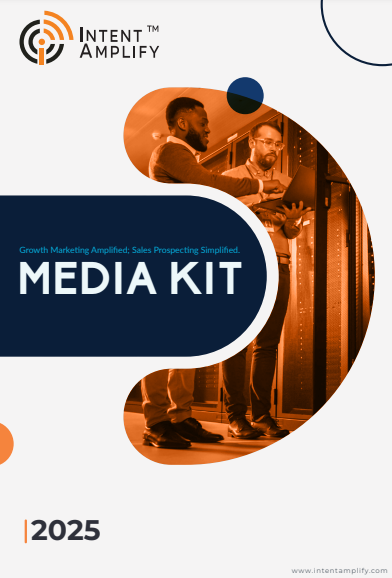
Intent Data in Action: Case Studies on Accelerating the SaaS Sales Cycle
- Last updated on: October 8, 2025
The SaaS market today is one of speed, precision, and timing. Every buying decision is driven by research, comparison, and digital signals that unfold long before a sales team makes contact. In such a competitive space, knowing who is ready to buy and when they’re ready has become the defining factor between missed opportunities and accelerated revenue. That’s where intent data comes into play. It’s a powerful force reshaping how SaaS companies identify, engage, and convert potential customers. Intent data can cut through the noise of broad targeting and shorten lengthy sales cycles. Additionally, it will help go-to-market (GTM) teams act on real buyer intent.
Recent studies suggest that more than 70% of B2B buyers conduct their research online before ever contacting a vendor. This means that by the time your sales team reaches out, your prospects are already well-informed. It can be more complex if it’s halfway down a competitor’s funnel. The organizations that thrive in this environment are those using intent data to engage prospects at the earliest signs of interest.
Understanding Intent Data and Its Role in SaaS Growth
Intent data is the digital fingerprint of buyer behavior. It refers to the signals that indicate when a company or individual is actively researching a particular product, service, or solution. These signals can come from a variety of sources. These include website visits, content downloads, product comparisons, and ad interactions. Even topic searches across third-party publisher networks are also included. When aggregated and analyzed, these actions form a map of where a prospect is in their buying journey. There are two major types of intent data:
First-party intent data:
Collected directly from your owned channels. This data shows how prospects interact with your brand.
Third-party intent data:
Captured from external platforms and publisher networks. It provides visibility into what topics and solutions your target accounts are researching elsewhere. Even before they land on your website.
For SaaS companies, this visibility is invaluable. Intent data doesn’t just reveal interest; it helps teams prioritize high-fit accounts, personalize outreach, and focus efforts on buyers showing active demand signals. Instead of pushing cold emails into the void, marketing and sales teams can target accounts that are already displaying behaviors aligned with their product offering.
The SaaS Sales Challenge: Why Acceleration Is Harder Than It Looks
SaaS businesses live and breathe in a subscription-driven economy where sales velocity determines growth. Yet, despite digital advancement, many still struggle with long, unpredictable sales cycles. Here’s why.
SaaS buying decisions typically involve multiple stakeholders. It is from technical evaluators to procurement teams and executive sponsors. Each plays a different role in approval, and every delay adds friction. Additionally, customers expect deep product understanding, tailored demos, and transparent ROI before signing up.
Traditional marketing models often fail in this landscape. Relying on broad MQL scoring or static lead lists no longer reflects true buyer intent. An account that downloads a whitepaper may not be ready for a sales call, while another showing high research activity across intent platforms may go unnoticed.
This is where intent data becomes the accelerant. It surfaces who’s visiting your website and it reveals who’s actively researching similar solutions across the web. Armed with this intelligence, SaaS teams can reach buyers earlier, tailor their messaging, and prioritize deals that are already heating up.
Intent Data in Action with Real-World SaaS Case Studies
The best way to understand the power of intent data is to see it in motion. Below are three SaaS companies that used intent-driven strategies to shorten their sales cycles and drive meaningful revenue impact.
Case Study 1: Analytics SaaS Platform Cuts Its Sales Cycle by 30%
One of our clients, A mid-sized analytics SaaS company, faced a familiar challenge. An overworked sales team is chasing too many cold leads. Their SDRs were spending hours personalizing outreach with minimal response rates, while genuine buying opportunities slipped through the cracks.
The company decided to integrate third-party intent signals from Intent Amplify into its account-based marketing (ABM) platform. The goal was simple. Identify companies researching topics like data visualization tools and business analytics software across digital channels.
Once integrated, the marketing team prioritized those high-intent accounts. Further, it tailored outreach messages around their specific topics of interest and timed follow-ups based on real engagement spikes.
Within four months, the impact was undeniable. The SaaS platform saw a 30% reduction in average sales cycle length and a 22% increase in SDR productivity. Sales conversations became more relevant. And conversion rates climbed steadily as teams focused their energy where it mattered most, on accounts ready to buy.
Case Study 2: Cloud Security SaaS Boosts Demo Conversions with Intent-Driven Personalization
This one is about a cybersecurity SaaS company that has also been our Client for the last 2 years. They offer cloud compliance and endpoint protection solutions. Before teaming up with us, they faced a different issue. low demo-to-deal conversion rates. Their campaigns reached a wide audience, but few leads converted because the messaging was too generic.
By leveraging topic-based intent data, Our Client segmented its target audience based on research activity around terms like “cloud compliance,” “zero trust security,” and “data protection frameworks.”
The marketing team used these insights to personalize ad creatives, landing pages, and outreach sequences. Instead of sending Standardized demo invitations, they crafted industry-specific narratives that addressed each segment’s most researched pain points.
The result was transformative:
- Demo bookings doubled within 60 days.
- The sales cycle was shortened by 27%, as prospects came to meetings already educated and ready to discuss solutions.
- Campaign ROI improved as budgets were redirected toward in-market accounts instead of cold segments.
This case shows how intent personalization can not only speed up the buying process but also make every marketing dollar more impactful.
Case Study 3: Collaboration SaaS Aligns Marketing and Sales Through Shared Intent Insights
Another SaaS company in the remote collaboration space struggled with alignment between its marketing and sales teams. Marketing generated large volumes of leads through gated content, but sales complained that few were sales-ready.
To bridge the gap, we introduced shared intent dashboards that integrated data from the Intent Amplify® ABM solution with CRM insights. This allowed both teams to view account-level engagement. This shows which companies were actively researching terms like “team productivity platforms” or “enterprise communication tools.”
This shift led to synchronized outreach. Marketing nurtured accounts showing moderate intent, while sales immediately followed up with those displaying spikes in research activity.
The outcome was significant:
- A 25% increase in MQL-to-SQL conversion within three months.
- Faster pipeline movement due to improved timing and message consistency.
- Stronger collaboration between teams that now operate on the same data foundation.
Intent data didn’t just speed up the sales cycle. It repaired the disconnect between teams. Eventually, this leads to better forecasting and predictable revenue momentum.
How Intent Data Accelerates the SaaS Sales Cycle
Intent data acts as both an early-warning system and an accelerator. It allows SaaS teams to focus on prospects that are most likely to convert, enabling smarter decisions at every stage of the funnel. Here’s how it drives acceleration step by step:
Discovery:
By monitoring research behavior across digital platforms, intent data surfaces potential customers before they even visit your website. This helps sales teams expand their pipeline with genuinely active prospects.
Engagement:
Knowing what topics matter to a target account enables personalized communication. Whether through email, ads, or outbound calls, messaging becomes far more relevant and timely.
Nurturing:
Instead of blanket drip campaigns, marketers can design nurturing tracks around specific interests. For instance, targeting accounts reading about “SaaS scalability” or “data integration APIs.”
Conversion:
With context on what buyers are researching, sales teams can tailor demos, emphasize competitive differentiators, and overcome objections proactively.
Expansion and Retention:
Intent data doesn’t end post-sale. Monitoring changes in customer intent signals can help identify upsell opportunities or spot early churn risks.
In essence, intent data transforms the SaaS sales motion from reactive to proactive. So, it gives GTM teams the foresight to act with speed and precision.
Best Practices for SaaS Teams
Turning intent data into a competitive advantage requires more than access. It needs operational alignment and strategic execution. Here are key practices SaaS organizations can adopt to put intent insights into action:
Integrate with Your Existing Tech Stack:
Connect intent data platforms like 6sense, Bombora, or Demandbase with your CRM and marketing automation systems. This ensures that insights flow directly into your sales workflows and campaigns without manual intervention.
Create a Shared Revenue Dashboard:
Centralize marketing and sales visibility. Shared dashboards help GTM teams coordinate outreach timing and prioritize the same high-value accounts. This reduces friction and enhances accountability.
Use Topic-Level Intent to Fuel Personalization:
Go beyond account-level data. Map buyer personas to specific intent topics to deliver precise messaging and content journeys that reflect their current research interests.
Refine Lead Scoring Models Continuously:
Use feedback from closed-won and closed-lost deals to refine your scoring logic. Intent strength, frequency, and recency should all influence your prioritization.
Embrace Collaboration Between Marketing and Sales:
The most effective SaaS organizations treat intent data as a shared language. They do treat it as a marketing metric. Regular meetings and alignment sessions ensure both sides are interpreting signals correctly and acting on them together.
When implemented effectively, these practices turn raw data into revenue acceleration. They also build a culture where every team. From demand gen to sales ops, speak the same language of intent.
Intent Data as the Future of SaaS Revenue Acceleration
The modern SaaS sales cycle thrives on data, but not just any data. It thrives on intent. In a world where attention is fragmented and buyers move fast, understanding real-time interest signals has become the new competitive edge.
Intent data gives SaaS teams something that traditional lead generation never could: foresight. It tells you which accounts are leaning in, what topics they care about, and when they’re most receptive to engagement. When paired with strong alignment and technology integration, it transforms guesswork into a predictable growth engine.
The SaaS companies leading the market today are those that have learned to listen before they sell. It’s reading buyer intent as fluently as their own sales scripts. As AI and predictive analytics continue to evolve, intent data will only grow smarter, faster, and more precise. For SaaS marketers and sales leaders, the message is clear. Your next opportunity is already signaling its intent. The question is whether you’re listening.
FAQs
- How is intent data different from predictive analytics?
Intent data shows current buying behavior, while predictive analytics forecasts future buying potential.
- How can I check if third-party intent data is accurate?
Compare intent signals with your first-party data or campaign performance trends to verify reliability.
- How often should intent data be updated?
Refresh intent signals weekly or biweekly to keep pace with fast-changing buyer behavior.
- Can intent data help with retention or upselling?
Yes. Tracking customer intent reveals churn risks and new cross-sell or upsell opportunities.
- What’s the biggest mistake teams make with intent data?
Using it as a static lead list instead of a real-time behavioral signal that requires continuous action.



